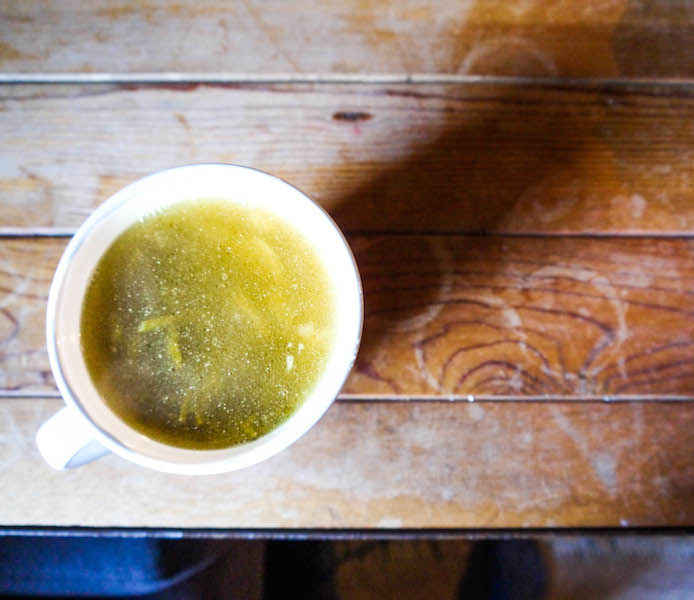I have a new weekly ritual. On Sunday, after my requisite loll-about with the New York Times, I go to the local grocery store, buy an organic chicken, and bring it home to make a most delicious tonic; Bone Broth. Sometimes I roast the chicken first, leaving some meat on the bones before turning it into soup. Other times I put the chicken in the pot raw, pulling it out after half an hour to remove the breast meat, then letting the rest of the body cook for several hours. Each week the broth is slightly different–casually so–based less on pre-meditated intention than what I have in the kitchen. One week’s broth may be fragrant with ginger and lemongrass, with wisps of silken seaweed swimming throughout. The next is darker, savory, heavily peppered and tasting of winter herbs. As with most of my favorite, repeatable dishes, the iterations for a good bone broth are endless.
Why drink a broth of bones, you might ask? Nourishment. It is my Nana’s kitchen in winter. It is the bowl of soup I drank in Ecuador after stomach flu. It is my morning cup (before coffee) after a night of overindulgence. It is the healing, warming, comforting, fortifying snack or meal or base of a soup I can always rely on to set me right. And this not just nostalgia talking. The age-old notion that chicken soup will cure what ails you did not come out of thin air. By cooking bones (chicken, fish, beef), slowly, at low heat, you extract minerals, amino acids, and collagen–all of which have a host of healing properties.
Glycine and proline–the amino acids in bone broth–improve digestion by increasing the production of gastric acid, promote the healing of wounds, support detoxification of the liver, and increase healthy connective tissue.
Collagen is basically the glue of the body. It is present in bones, ligaments, tendons, skin, marrow, cartilage and lymph. Extracted collagen, used in food, is called gelatin. Good sources of gelatin help heal and lubricate the mucosal membrane in the gastrointestinal tract, help build and repair cartilage and bone, and aid in digestion of protein.
Calcium, Phospherous and Magnesium come out of those bones too. Each mineral plays an important regulating function of the body–bone health, muscular contraction and relaxation, intraceullar pressure balance, and proper nerve transmission, to name a few.
(psst, athletes, if it isn’t already obvious, the above translates to better recovery after a workout.)
So, yeah, bone broth is good for you. It’s soothing, and it supports and elevates some of the basic bodily functions. But, perhaps more importantly, when made with care and good ingredients, it is downright delicious.
Note #1: A splash of apple cider vinegar in the water will help pull the nutrients from the bones.
Note #2: Your body needs Vitamin C to help absorb collagen so add good veggies to your broth while cooking to extract additional vitamins and minerals.
Note #3: For a beef or fish bone broth recipe and more information on the benefits of bone broth, go here.
Note #4: As I mentioned, there are many iterations of this broth. The one below is relatively basic. Feel free to add more or different vegetables, play with new combinations of dried spices and fresh herbs, or stick to nothing more than chicken, water and salt to start and build from there.
Chicken Bone Broth
1 whole organic or free range chicken or chicken pieces (2 bone in breasts, 4 drumsticks, 2 chicken feet for extra collagen if desired)
2 carrots, chopped
2 stalks celery, chopped
1 medium onion, chopped or thinly sliced
2 cloves garlic, crushed
1 bay leaf
1 T apple cider vinegar
1 T black peppercorns
1 handful fresh cilantro
1 handful fresh parsley
1/2 bulb fennel and/or fennel tops, chopped
a couple big pinches of coarse sea salt
Rinse the chicken and remove the giblets if they’ve been left in. Set aside for other use or discard.
Place all of the ingredients in a large stock pot and add enough water to just cover the chicken. Bring to a boil over medium-high heat, then reduce to low heat and cook for 2-24 hours. Once the soup stops boiling you may see a sort of scum rise to the top. Skim this off with a spoon and discard.
You can remove the chicken after about half an hour to cut the breast meat off if you want to make chicken salad or just have cooked chicken on hand for later use. I usually leave the drum stick meat on and eat it when I turn the soup off, when the meat is soft enough to fall off the bone. You can certainly do this with the breast meat as well if you so desire.
Once you have cooked the soup to your desired amount, drain the soup into a large glass or metal container through a colander. The vegetables will be very mushy at this point. You can discard them or eat them. Despite their texture they will be very flavorful. Save any chicken meat you like and discard all unwanted solids.
Let the broth cool before refrigerating. The broth will take on a jello-like consistency once cooled due to the extracted collagen. The more jello-like, the more collagen you extracted. It will liquify as soon as heated. You may also see a layer of hardened fat on the broth once it has cooled. This can be removed with a spoon and discarded before reheating.
As you reheat the broth, taste it. It may call for a small pinch of flakey sea salt. Drink morning, noon or night as desired, or use a base for any favorite soup recipe. Let the healing begin.



 Subscribe via RSS
Subscribe via RSS